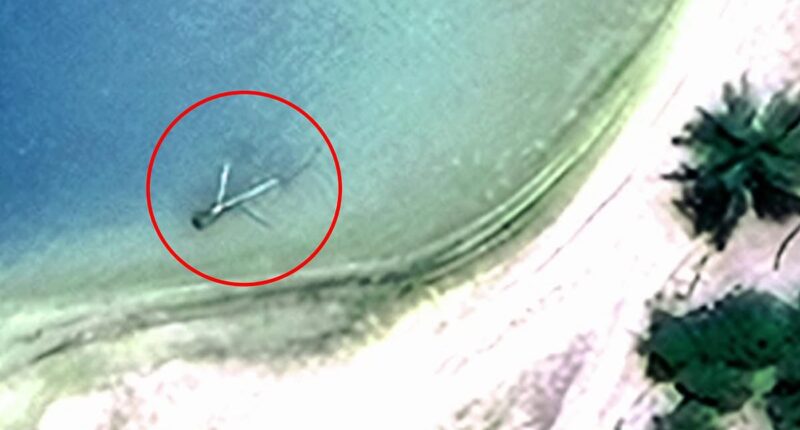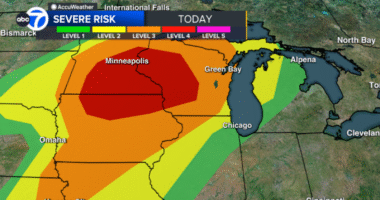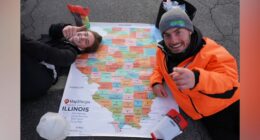In some small way, Dr Richard Pettigrew hopes he’s wrong.
An experienced archaeologist is gearing up to lead a team to a Pacific reef, following satellite images that suggest the presence of the wreckage of the pioneering aviator Amelie Earhart’s plane.
Should Dr. Pettigrew’s assumptions prove to be correct and he manages to unearth Earhart’s Lockheed Electra, it could potentially bring an end to a decades-old mystery surrounding her disappearance that has perplexed investigators for close to ninety years.
But he would also reveal a grim truth about the tousled-haired heroine’s fate.
The discovery would indicate that Earhart veered off course during her global flight, exhausted her fuel supply, and made a forced landing on a remote, uninhabited island where she ultimately perished from starvation and dehydration, becoming a meal for oversized crabs.
‘The very idea that she wasted away on the island and eventually died and got eaten by coconut crabs — that’s a horrible, horrible vision,’ Pettigrew told Daily Mail.
‘I don’t like thinking about it, but it’s inevitable.’
It would be a macabre end to the puzzle of Earhart and her navigator, Fred Noonan, who disappeared in the Pacific on July 2, 1937, en route from Papua New Guinea to Howland Island.

Earhart (born 1897) standing in front of the Lockheed Electra in which she disappeared in 1937

Researchers will in November investigate a mystery object on a remote Pacific island that they believe is Earhart’s lost Electra
Earhart’s bid to become the first female pilot to circumnavigate the globe ran into strong headwinds, and she radioed that she was running low on fuel.
The loss of an aviation pioneer who’d inspired women to chase their dreams sent shockwaves around the world.
The US Navy scoured the area for 16 days but found no trace.
The longstanding official theory is that the plane ran out of gas, crashed and sank into deep ocean waters off Howland Island.
But the absence of a wreckage spawned a slew of alternate explanations about her fate.
Theories have veered into the absurd, including abduction by aliens, or Earhart living in New Jersey under an alias.
Some speculate Earhart and Noonan crash-landed on Mili Atoll, 800 miles northwest of Howland, and were taken prisoner by the Japanese and transported to Saipan, where they died in captivity.
Various teams have tried to pinpoint the crash location by scanning the ocean floor or using computer models based on Earhart’s radio transmissions.
No one has found a verified plane part or bone fragment.
Last year, it looked as if the mystery might be solved when explorers at South Carolina firm Deep Sea Vision discovered an ‘aircraft-shaped object’ in the area of the Pacific where the legendary aviator vanished.
However, a second expedition dashed hopes, revealing that the object was not an aircraft but simply a bunch of rocks.
Since the late 1980s, many investigators have probed another theory: that Earhart made an emergency landing on a dry flat stretch of coral reef off what was then known as Gardner Island, southwest of Howland.

Veteran archaeologist Dr Richard Pettigrew on a previous expedition to Gardner Island, now called Nikumaroro

Earhart was on one of the final legs of her round-the-world flight in 1937 when she disappeared

Coconut crabs can weigh up to 9lbs (4kg) with a body length of 16 inches, and have large claws with which to crack open coconuts

Last year, Deep Sea Vision released sonar images (pictured) they believed might be the remains of Earhart’s plane but it turned out to be a bunch of rocks
Researchers at the International Group for Historic Aircraft Recovery (Tighar), point to Earhart’s last in-flight radio message heard by the Coast Guard cutter Itasca, which put her on course for Gardner.
A series of distress calls in the days after the disappearance, apparently made by Earhart from a safely-landed Electra, also point to her having landed on Gardner, though these may have been hoaxes.
Various expeditions to that distant island, now called Nikumaroro, have uncovered bones, a campfire, clothing, and navigational gear, that may suggest Earhart ended her days there.
Her remains may have been devoured by the carnivorous coconut crabs, which inhabit the island and weigh up to 9lbs and have claws powerful enough to crack open coconuts.
A multi-million-dollar search of waters off Nikumaroro in August 2019, spearheaded by ocean explorer Robert Ballard, found no trace of Earhart’s twin-tailed monoplane there.
Pettigrew, 77, of the Oregon-based Archaeological Legacy Institute (ALI), says Ballard was looking in the wrong spot.
He’s collected dozens of aerial and satellite images of the island that appear to show a metallic object, about the size of the Electra, in the shallow waters in Nikumaroro’s lagoon interior.
The so-called Taraia Object is about the size of the Electra’s fuselage and tail.
It was first noticed in 2020, but can be seen in photos dating back to 1938. Now, and at other times, it’s been covered in sludge.

Researchers have been investigating Nikumaroro Island as Earhart’s final stop since the late 1980s

Earhart was flying a Lockheed Model 10 Electra with navigator Fred Noonan (right) when their plane vanished near Howland Island

Earhart’s plane vanished on July 2, 1937. In the last in-flight radio message, Earhart said: ‘We are on the line 157 337 …. We are running on line north and south.’ These numbers refer to compass headings – 157° and 337° – and describe a line that passes through the intended destination, Howland Island

American aviator Amelia Earhart poses atop her Lockheed Vega Monoplane in about 1932
In November Pettigrew plans to lead a dozen researchers aboard two boats from the Marshall Islands on a $900,000, five-day expedition to Nikumaroro and show the ‘object’ is indeed the Electra.
‘The excitement is palpable,’ he says.
‘I’ve looked at this back and forth, up and down, in and out, for years now. And I think the evidence is quite overwhelming. I am very confident, and I think we’re going to come home with the goods.’
But he recalls the swagger of other explorers before they embarked on their own, doomed missions, and checks himself.
‘I’m also aware that I could be wrong,’ he adds.
After so many failed, costly bids to locate the Electra by other explorers, Pettigrew appears to be struggling to raise funds.
He’s pushed back the mission by four months and has yet to rent boats and secure permits from Kiribati’s government.
If he uncovers the Electra, Pettigrew says he’ll install a webcam to ward off relic hunters until salvage work begins next year.
Raising the plane and placing it in a museum would likely cost hundreds of millions of dollars.
It could also spawn rival claims from ALI, Kiribati, and Purdue University in Indiana, which donated some of the funds that paid for Earhart’s plane.
Curators at the Smithsonian’s Air and Space Museum support the mainstream crashed-and-sank theory, but are understood to be keen to display a salvaged Electra.
Such is the lure of Earhart, 88 years after she went missing on her way back to California, says Pettigrew.
‘She was ahead of her time and highly admired by people,’ he says.
‘It was a horrible tragedy that she disappeared, but that that fact of her disappearance has also kept her memory alive, because the mystery is constantly haunting people.’


















